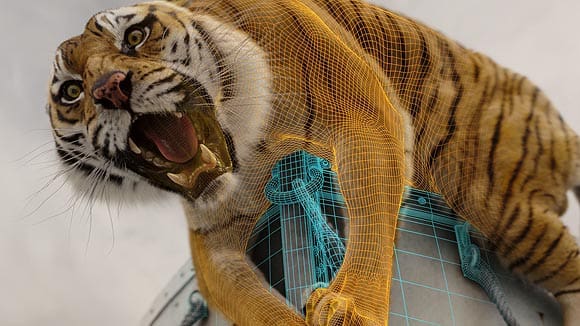

An Appreciation of the Tiger in “Life of Pi”

My favorite animated performance in Pixar’s Brave was the Queen-as-a-bear character. It was a fine piece of cartoon-inspired anthropomorphized animation that supported the storyline and convinced the viewer that there was a struggle of personalities occurring within the bear.
On the opposite end of the spectrum is the animation of the tiger, Richard Parker, in Ang Lee’s film adaptation of the novel Life of Pi. The aims of the Rhythm & Hues animators who created the tiger were quite different than those of Brave‘s animators, but it is no less an artistic accomplishment.
In Life of Pi, the tiger shares the screen for long periods of time with a live-action actor, and the goal was to create a performance that was as naturalistic, animalistic and photorealistic as possible. They succeeded on all counts, and created a convincing character that the viewer never questions as being anything but a flesh-and-blood tiger. In fact, the film’s visual effects supervisor Bill Westenhofer, said in an interview that there were even shots of a real tiger mixed in seamlessly with the CG: “By doing that, it set our bar high for CGI. We couldn’t cheat at all. It pushed the artists to go and deliver something that’s never been done before, something as photo-real as anyone has ever done with an animal.”
Impressive as it is, one can’t help but feel that the tiger is an anticlimactic moment in the history of CG animation. There has been a decades-long buildup toward achieving such a character, and with each film, artists have progressively gotten closer and closer to this goal. The tiger is not a revolution, but rather the latest evolution of CGI’s march toward photoreal and natural digital actors.
Life of Pi’s animation director Erik-Jan De Boer has had plenty of time to develop an approach to naturalism over the past decade-and-a-half, primarily at Rhythm & Hues, which has distinguished itself as one of the top effects houses for CG animals. De Boer’s R&H credits include animals in films like The Golden Compass, Cats & Dogs, Stuart Little, Babe: Pig in the City and both Scooby-Doo features.
Significant portions of Life of Pi beyond the animals were also computer-generated and this article on FXguide serves as a primer to the use of CG in the film. Among the eleven Oscar nominations that the film earned last week was a nod for its visual effects. De Boer shares the nomination with Bill Westenhofer, Guillaume Rocheron (vfx supervisor: MPC) and Donald R. Elliott (special effects technician). It would be a surprise if the film didn’t win in this category.
Film has always been about creating an illusion, and today, that illusion is being achieved in large part through animation. Directors like Ang Lee and James Cameron have transformed themselves into (part-time) animation directors with little fanfare, and some of the most technologically advanced pieces of character animation can be seen in their films. The tiger in Life of Pi is an impressive accomplishment, and shows that photoreal animals are now within the grasp of today’s animators. Anyone who is interested in the development of our art form owes it to themselves to check out the film.

.png)